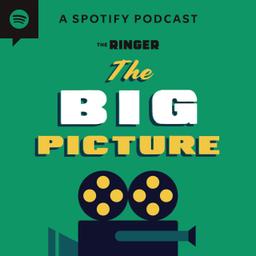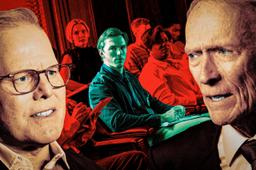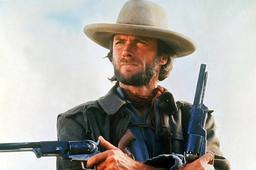
As much as the landscape of Hollywood blockbusters changed in 2024, it also stayed the same. Of the 10 highest-grossing movies of the year, only two (Deadpool & Wolverine, Venom: The Last Dance) happened to be superhero tentpoles. Whether you believe superhero fatigue is real or that Marvel and DC were simply reshuffling the deck for a much-improved 2025, it’s clear that these films aren’t the only game in town. Of course, the rest of the top 10 is exactly what we’ve come to expect: sequels upon sequels (Inside Out 2, Moana 2, Dune: Part Two, and so on) along with an adaptation of a beloved Broadway hit (Wicked). In other words, when it comes to IP’s dominance in Hollywood, 2024 has been business as usual.
For my job, I get to watch a lot of these blockbusters. (I’ve been avoiding Wicked on principle, however.) Don’t get me wrong, I love films of all shapes and sizes. Ideally, a discerning moviegoer will be just as willing to check out something small, like I Saw the TV Glow or The Taste of Things—both great, both worth your time—but for my money, there’s nothing quite like a big film that makes a big impression. Sharing an experience like Top Gun: Maverick with friends and family? These moments are why, in the immortal words of Supreme Leader Kidman, we come to this place for magic.
But there’s another reason I’m drawn to these kinds of tentpoles: It’s just as interesting to see what filmmakers can accomplish on the grandest scale. Sure, many directors have to color within the lines of preestablished IP if they want to get their hands on a nine-figure budget, but the best ones still allow their sensibilities to shine through. Look at the way Denis Villeneuve transports audiences to the desert planet of Arrakis, or how Greta Gerwig has her cast dance the night away in Barbieland. And for up-and-coming filmmakers, leveling up to a blockbuster remains a fascinating inflection point that could go the way of Michael Sarnoski taking the reins of A Quiet Place: Day One (promising) or Nia DaCosta entering the Marvel Cinematic Universe (depressing). Even Gerwig, once an indie darling, has made it clear that, post-Barbie, she intends to be a big-studio director.
But making movies at this scale isn’t just a young person’s game: Last year, octogenarians Martin Scorsese and Michael Mann proved they’ve still got their fastballs with Killers of the Flower Moon and Ferrari, respectively. And in 2024, four movies from directors who are well past retirement age are the ones I’ve found myself thinking about the most. Not all of these films are necessarily great—nor are they all nine-figure behemoths or made within the studio system—but they do underline that cinema’s old masters still have plenty left to teach us. Here’s what I’ve come to appreciate from each of them this year.
George Miller
Mad Max doesn’t have your typical franchise origin story. The demented brainchild of George Miller, the series started with a shoestring budget of $350,000: no small feat for an action flick predicated on cars smashing into each other on the back roads of Australia. (Miller couldn’t afford to pay some of the crew members, so he bought them cases of beer.) Miller, in turn, didn’t have grand designs to turn Mad Max into a franchise, and each sequel has marched (revved?) to the beat of its own drum. Continuity has rarely mattered, as evidenced by Bruce Spence playing different aeronautic characters in The Road Warrior and Beyond Thunderdome. If the original Mad Max was a record-breaking single, each sequel has been a remix using different instruments to orchestrate a familiar melody.
Which brings us to Furiosa: A Mad Max Saga. A prequel to Fury Road, the film covers the early years of Furiosa (previously played by Charlize Theron, now portrayed by a combination of Alyla Browne and Anya Taylor-Joy) as she’s kidnapped from the Green Place by the biker warlord Dementus (Chris Hemsworth) before finding herself in the employ of Immortan Joe (Lachy Hulme). Anyone floored by the vehicular carnage of Fury Road—pound for pound one of the best action movies of the century—was considerably hyped for Furiosa. Sadly, that enthusiasm didn’t extend to the wider moviegoing public, as Furiosa delivered the worst Memorial Day weekend at the box office since 1995.
We can diagnose the reasons why, exactly, Furiosa didn’t catch on with audiences: It took too long to make a follow-up to Fury Road, Fury Road was an excellent movie that did only OK business to begin with, and franchise stalwart Max Rockatansky was absent. But such concerns do the film a disservice: Furiosa directly leads into the events of Fury Road, yes, but it deserved to be met on its own terms. Whereas Fury Road was a gnarly series of chase scenes—filmed so audaciously over a grueling shoot that other directors can’t comprehend how the stunts were pulled off—Furiosa is something in the spirit of David Lean: a sweeping epic that treats Furiosa’s journey as a myth upon which we can understand the Wasteland. This isn’t nostalgia; it’s innovation.
Most of all, Furiosa just kicks a ridiculous amount of ass. That chase sequence on the Fury Road is worthy of Valhalla. Taylor-Joy and Hemsworth are at the top of their games. Furiosa’s aesthetic is glossier than Fury Road’s—closer to Miller’s tragically underseen Three Thousand Years of Longing—but it makes the Wasteland feel like a character in its own right. It’s utterly transportive stuff, the work of a filmmaker who has no interest in repeating himself. Hollywood is littered with great blockbusters that went underappreciated in their times, and Furiosa has, unfortunately, joined their ranks. But don’t let the underwhelming box office numbers detract from what Miller accomplished: He had it in him to make it epic, and Furiosa shifted the franchise into a new gear.
Francis Ford Coppola
Francis Ford Coppola’s résumé speaks for itself. In the ’70s alone, he knocked out The Godfather, The Conversation, The Godfather Part II, and Apocalypse Now, which many (myself included) would argue is the greatest four-movie run in history. In the 21st century, however, Coppola’s output has diminished significantly, and it’s been a long time since a major studio entrusted him with a big budget. For some filmmakers, a lack of opportunities at the end of their career might force them into retirement; for Coppola, it meant cashing in on his wine empire.
Megalopolis has been Coppola’s passion project for decades. A fable that imagines modern-day New York going the way of Ancient Rome, the film came with a $120 million budget that would never be recouped in full. But without any studio oversight, the 85-year-old auteur ensured he’d be going out on his own terms, a worthy pursuit in and of itself. Still, Megalopolis’s journey was fraught before it even made it to theaters: The early reviews out of Cannes were mostly unforgiving, a trailer with fake, AI-generated quotes from critics was released, and footage came out of Coppola kissing multiple extras on set. Throw in the fact that Coppola included a scene featuring a “live participant” from the audience—something few theaters could accommodate—and this had all the makings of a shit show.
Nothing in the lead-up to Megalopolis, however, could prepare you for the experience of actually watching Megalopolis. The film’s warning that America could collapse like Ancient Rome—by falling victim to the “insatiable appetite for power of a few men,” as Laurence Fishburne’s character tells us in a voice-over—is painfully heavy-handed. The members of the deep ensemble, which includes Adam Driver, Giancarlo Esposito, Nathalie Emmanuel, Aubrey Plaza, Shia LaBeouf, Fishburne, Jon Voight, and Dustin Hoffman, seem like they’re all in different productions. (I wish everyone matched Plaza’s and LaBeouf’s chaotic energy.) The visuals are legitimately breathtaking in one moment and then wouldn’t feel out of place in a PlayStation 2 cutscene in the next. The film’s title references a substance known as Megalon that is capable of saving humanity; on my life, I couldn’t tell you what the hell it actually does. An exchange in the movie, during which you can briefly spot a boom mic coming in and out of frame while Emmanuel’s Julia Cicero says “entitles me?!” several times, can be described only as Tommy Wiseau–core.
But for all of Megalopolis’s faults, I can honestly say I’ve never seen anything quite like it. This is the antithesis of what executives want from their blockbusters: risky, unwieldy, and uncompromising. It’s the kind of big swing that will rarely, if ever, exist at this price point again—unless another director has a liquor empire they’re willing to divest from. I celebrate Megalopolis less for what it achieves on-screen and more for what it represents: the ultimate form of directorial self-indulgence. That’s priceless. I’ll gladly spend the rest of my life trying to plow through the riches of Coppola’s Emersonian mind.
Ridley Scott
There’s a worthy debate to be had about whether Ridley Scott is a prolific auteur or one of cinema’s great salesmen, and Gladiator II might be the ultimate case study. It is, after all, the highly anticipated sequel to Gladiator, a Best Picture winner that, for all its crowd-pleasing moments, hardly necessitated a follow-up. (That said, I would’ve donated my life savings to watch Nick Cave’s bonkers pitch for a Gladiator sequel, in which Russell Crowe’s Maximus battled Roman deities in the afterlife.) More than Scott’s Alien follow-ups, Prometheus and Covenant, Gladiator II feels closer to a nostalgic cash-in than another genre exercise from a dude who loves making historical epics. (Light on historical accuracy, obviously, but honestly? Just let Sir Ridley cook.)
Here’s the thing: Does it really matter? We are, sadly, in a moviemaking era in which nostalgia is all the rage, and studios green-lighting remakes, reboots, and legacy sequels is as certain as the sun setting at the end of the day. If this is the hand that mainstream audiences are being dealt, I’ll take Scott dipping into his old bag of tricks over, say, someone as gifted as Barry Jenkins subjecting himself to a photorealistic Mufasa origin story for Disney. Much like its predecessor, Gladiator II begins with its protagonist (in this case, Lucius Verus Aurelius, played by Paul Mescal) losing his wife and home to the Roman Empire before being sold into slavery. Lucius’s owner, Macrinus (Denzel Washington), sees his potential as a gladiator—one thing leads to another, and Lucius, like Maximus before him, is testing his might in the Colosseum.
Gladiator II isn’t exactly breaking the wheel: Once again, Rome is crumbling from within thanks to the unworthy emperor(s), the battles are unsparingly brutal, and the dream of a better Rome rests on an unlikely savior. There’s nothing that the film improves upon from the original Gladiator, other than the inclusion of sharks in the Colosseum. (More blockbusters should throw in sharks for the hell of it.) You can find many faults in Gladiator II’s derivative story, but the fight scenes are dynamic (CGI baboons notwithstanding), and the imagery is reliably stunning, particularly when Lucius briefly crosses over into the afterlife. Besides, if these types of IP extensions are the cinematic equivalent of fast food, I want an artery-clogging feast from a genre that’s fallen out of favor.
Going back to his days as a commercial director, Scott knows how to put on a show, whether he’s trying to sell you a Macintosh or whisking you away on another trip through history. Maybe those instincts are why some critics are hesitant to label Scott as one of our great auteurs—I’m of the opinion that his brother, the late Tony Scott, was the superior filmmaker—but Gladiator II is the best version of what it could be. If that’s faint praise, so be it. I didn’t go into Gladiator II with the expectation that it would break new ground: I came to be entertained. On that front, it gets a thumbs up.
Clint Eastwood
A figure like Clint Eastwood is something of a dying breed in the studio system: a filmmaker who specializes in mid-budget dramas catered to adults. Eastwood has directed more than 30 movies for Warner Bros., including the Best Picture winner Unforgiven, and these projects have, more often than not, succeeded commercially and critically. All of which makes the studio’s decision to bury Eastwood’s latest (and final?) film, Juror #2, even more perplexing. CEO David Zaslav pointed to 2021’s Cry Macho, one of Eastwood’s few box office bombs, as an example of the kinds of movies Warner Bros. shouldn’t finance going forward. From a purely business standpoint, however, that argument doesn’t carry much weight. For one, Cry Macho arrived one year after the start of the pandemic, when Warner was releasing movies simultaneously on Max—not exactly a winning recipe for box office success. More importantly, late-career Eastwood has demonstrated he’s still got plenty of commercial appeal with American Sniper, Sully, and The Mule. (And, while we’re at it, justice for Richard Jewell.)
In any case, Juror #2 was released in fewer than 50 theaters across the United States last month; it will be available to stream on Max on December 20. I was lucky enough to see Juror #2 on the big screen, and there’s no two ways about it: It’s downright criminal that Warner has given this thing such a muted rollout. The film has a wonderfully juicy premise: Journalist and dad-to-be Justin Kemp (Nicholas Hoult) has been selected to serve on a jury in the case of James Michael Sythe (Gabriel Basso), who’s been charged with murdering his girlfriend (Francesca Eastwood). As the facts unfold, however, Justin realizes that he wasn’t just at the same bar as the accused the night of the murder: After driving home and assuming he hit a deer on the side of the road, Justin might be the guilty party. (When I explained what Juror #2 was about to my dad—Eastwood’s target audience—he couldn’t be more locked in.)
From there, Juror #2 finds Justin trying to convince the rest of the jury panel that Sythe is innocent, a fascinating tightrope that requires him to make a compelling argument without drawing too much attention to himself. (One morbidly funny snag: the panel’s inclusion of a former homicide detective, played by J.K. Simmons.) But the real meat of the film is the moral dilemma Justin ultimately faces: Just as Sythe’s history of abuse has already condemned him, Justin would be judged as someone recovering from alcoholism if he confessed. (He was tempted to break his sobriety at the bar but stood firm.) Eastwood’s style here is no-nonsense and unshowy—on brand for someone who notoriously films as few takes as possible—but what makes Juror #2 so gripping is that it lives in the kind of ethical gray areas our justice system isn’t always equipped to handle.
Juror #2 doesn’t have anywhere near the budget of the other movies I’ve highlighted, but that’s the point. In a recent Ringer culture meeting, my colleague Justin Sayles said, in response to Juror #2 landing at no. 2 on Adam Nayman’s year-end list, that it would be closer to a top-40 film if it came out in the ’90s. I think he’s being too harsh on the quality of Juror #2, but the fact that it has fewer contemporaries in this era is an indictment of the modern studio system, which supports so little outside of the mega-blockbusters. I wish Juror #2 was seen by its own distributor not as an albatross to be buried but as an example of how to service mainstream audiences starved of adult-oriented fare.
More than anything, what I admire about Juror #2 is its timeless quality—the sense that it could grip moviegoers if it came out seven decades ago or 30 years in the future. As far as I’m concerned, its greatness is an open-and-shut case. And in a year in which cinema’s elder statesmen showed us how to innovate within an established franchise, embrace self-indulgence, and deliver crowd-pleasing entertainment, the 94-year-old Eastwood taught us the greatest lesson of all: Some things should never go out of style.











